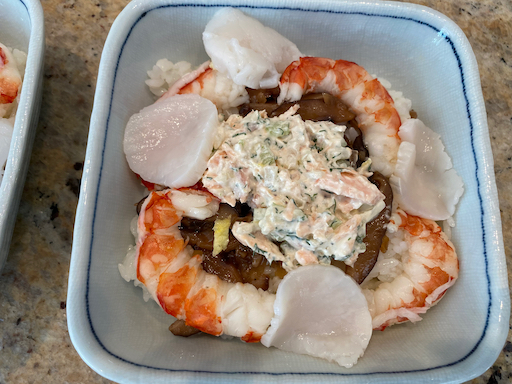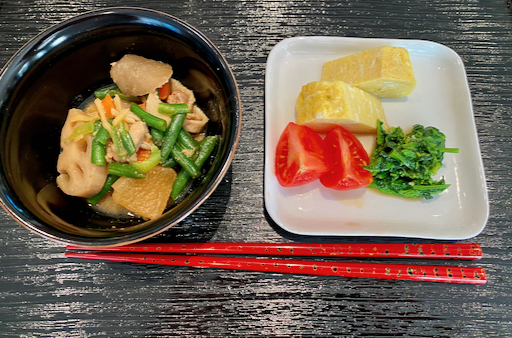Tuesday, June 7, 2022
Scattered sushi ちらし寿司
Friday, June 3, 2022
Crispy Cheese round カリカリチーズ
One evening, my wife served this as a surprise. According to her, she saw a similar dish on YouTube WebSpoon. The original used slices of pepperoni. Since she did not have pepperoni, she used black olives. It was crispy and cheesy with parmesan flavor coming through. Good appetizer with wine.
I will ask how she made it.
Ingredients:Grated cheese of your choice and taste. The amounts are arbitrary. I used:
Smoked gouda
Cheddar
Monterey Jack
Mozzarella
Parmesan
Tomato sauce
Black olives (or pepperoni)
Directions:
Grate the cheeses and mix together. Make little mounds of the cheese mixture on a cookie sheet lined with parchment paper. (The parchment paper is important because it makes it possible to remove the cheese once its melted). Spoon the tomato sauce on the mounds and top with whatever you are using as the topping; olives or pepperoni. Heat in the oven at 390 degrees for 10 minutes. The cheese will melt and brown.
Tuesday, May 31, 2022
Shrimp in spicy mayo sauce エビマヨ
My wife found 4 frozen good-sized shell-on shrimp from Great Alaska Seafood, lonely and tucked hidden under a number of other items in the freezer door shelf. She asked me if I could make something with them. I am familiar with popular Japanese shrimp dishes called “Ebi-chiri*” エビチリ and “Ebi-mayo*” エビマヨ. (Japanese are very fond of two condiments; ketchup and mayonnaise). I got an inspiration from these dishes and made this (slightly) spicy mayo sauce for the shrimp. I also added blanched sugar snaps since I had them.
*Digression Alert: Ebi-chiri was supposedly invented by Chin Kenmin 陳建民 (the father of Iron Chinese Chef Chin Ken-ichi 陳健一) based on a Sichuan dish called 乾焼蝦仁 modified to suit Japanese taste. The origin of “Ebi-mayo” appears less certain but it was based on an American Chinese dish of shrimp with Aurora sauce (mixture of ketchup and mayo) which was improved upon by a Chinese Chef in Yokohama. There are many variations of these two recipes.
This dish was impromptu but it came out rather well for a small appetizer. Despite the fact the frozen shrimp had been abandoned for some time in the freezer door shelf they tasted very nice; no iodine flavor and good firm texture.
Ingredients: (two small servings)4 shrimp (I used 4 shell-on frozen shrimp), thawed under running water, shell removed, brined in cold salted water for 5 minutes, washed in cold running water and patted dry
Olive oil for frying
Sauce (mix the ingredients in a small bowl)
2 tsp mayonnaise
2 tsp Greek (strained) yogurt
1/2 tsp Sriracha or any other hot sauce such as gochujang
Directions:
Lightly salt the shrimp and cook in a pan with olive oil, turning few time for total of 1 minute.
Set aside the shrimp
Add the sauce warm it up and then put back the shrimp, add the sugar snaps
Serve immediately.
Saturday, May 28, 2022
Chicken with Avocado miso dressing アボカド味噌ドレシング
We used to subscribe New York Times Cooking. It was rather expensive for just the cooking section so we eventually cancelled the subscription. In any case, this is a recipe called ”Creamy Avocado-miso dressing” and it is from NYT Cooking. Since we had ripe avocado on hand and the recipe uses miso, we deemed this worth a try. This was supposedly “salad dressing” for “hearty” greens, a warm grain bowl or grilled vegetables. We tried it as a topping for the homemade cheese wife made and as a dip for blanched cauliflower. Both tasted good. When we thawed a sous-vide cooked chicken breast, in addition to my traditional shredded chicken dish using sesame dressing, as per my wife’s suggestion, I made half of the shredded chicken with the avocado miso dressing. In the picture below, the left is with sesame dressing and the right is with avacado-miso dressing.
The sous-vide cooked chicken breast is perfect for this type of dish. The meat is soft and moist.
Ingredients:
1 ripe avocado, halved and pitted, flesh removed from skin
1/4 cup lemon juice (I used Meyer lemons since I had them).
2 tbs olive oil
1 tbs vinegar (I used rice vinegar)
1 tbs white miso (I used “awase-meso” which is mixture of red and white miso).
1tbs honey
1/2 tsp kosher salt
1/2 tsp black pepper
Directions:
Combine all ingredients in a mini-food processor and blend until smooth (shown below).
Wednesday, May 25, 2022
Steak dinner with Insignia 2012 ステーキとインシグニア2012
We rarely eat steak. This time, on the strong recommendation from my wife’s sister, we got a “special”package from Omaha Steaks which included, among a lot of other things, filet mignon. (It was called “Butcher’s cut”. We are not sure where this cut ranks on their quality scale of steaks). In any case, an occasion called for a special dinner and wine. So we cooked the steak and opened 2012 Joseph Phelps Insignia. The package from Omaha Steaks also included scalloped potato (shown here lower right) which I served with the steak, caprese salad and sautéed green beans.
The wine was excellent. It was not too aged with nice dark fruit, vanilla and chocolate and well structured but mellowed tannin. In general we are not a great fans of old wines but this was just nicely aged for us to enjoy.
Tuesday, May 17, 2022
Pork belly and diakon simmered in miso 大根と豚バラ肉のみそ煮
We have been getting gourmet meat such as duck and lamb from D’Artagnan. This time, we got an email promotion from them for pork belly from young pig called “porcelet”. Since we have not had pork belly (from adult pig or otherwise) for sometime (we usually get it from Whole Foods), we decided to give it a try. It arrived hard chilled with skin on. It was also much larger than we expected. Although the ad said it was 6 lbs. it was essentially half of the entire belly and we realized that in its present shape it probably would not fit in our freezer so I immediately divided it into three portions. I vacuum packed and froze two and thawed one. I made several dishes from the one piece I thawed. One dish is shown below. I thinly sliced a small portion while it was semi frozen. This preparation is called “buta-bara komagire” 豚バラ細切れ and is usually used to “season” other ingredients, mostly vegetables, rather than served as a “meat dish”. I used it to make a Japanese style miso simmered dish with root vegetables. The original recipe came from erecipe, a Japanese recipe site. One evening I served this dish (left) with dashi-maki omelet, rapini buds (substitute for “nanohana” 菜の花 dressed in mustard-soy sauce or “karashi-jouuyu” 辛子醤油 and skinned Campari tomato.
150 gram (1/3 lb) Pork belly, thinly sliced
1 carrot, medium, peeled and cut into bite size (“rangiri” 乱切り).\
Lotus root (renkon), I used frozen already cut ino slices, I used 4 which was cut into half circle.
1/3 Gobo burdock root, skin scraped off and cut into bite size (“rangiri”), soak it in vinegared or acidulated water until use (this is my addition since I had some left over gobo)
1 small piece of ginger root, skin scraped off and cit into julienne.
Simmering liquid
150 ml Japanese both
3 tbs sake
1 tbs mirin
1 tbs sugar
2 tbs miso
1 tsp soy sauce (this is added at the end of cooking)
Directions:
Friday, May 13, 2022
Beef tongue carppaccio 牛タンのカルパッチョ
My wife loves beef tongue but not the way it’s usually prepared in Japan (thinly sliced and grilled). As a result I usually prepare the tongue by boiling it in water with some aromatics which is how the beef tongue she ate as a child was prepared. (She refers to it as the Pennsylvania Dutch rather than Japanese method of preparation. The Pa Dutch method results in a meat that is extremely tender and melts in the mouth. The Japanese method in contrast results is a fairly tough and chewy meat. As my wife would say, “Which is the best method of preparation? What was the question?”) After removing the skin, I thinly slice it and make sandwiches using pumpernickel bread with mayo and mustard. (Again made to the exacting specifications of the tongue sandwiches my wife used to eat as a child.) Portions are further cooked as a Japanese-Western style beef tongue stew. (Which by-the-way was not something my wife used to eat as a child but likes non-the-less.)
We have not able to get beef tongue for a while. Although we know one of the grocery stores usually carries it, we have not been there recently since we are getting grocery home delivery. But an unexpected event led us to be at this particular grocery store and since we were there we snagged a rather large beef tongue. We enjoyed the tongue over several days as sandwiches and stew with spaetzle. I finally used the last portion of the tongue to make carpaccio (left in the picture below) and a small salad in Japanese-style (made using the PA. Dutch style prepared tongue, of course) with ponzu, yuzu-kosho, onion, cucumber topped with sesame seeds (right)
For the other salad, I just used the cucumber and onion left over from the previous salad. I arranged it with the onion on the bottom, the tongue (thinly sliced) next and topped with the cucumber. I dressed it with ponzu ポン酢 mixed with Yuzu-kosho 柚子胡椒 and topped with sesame. (The dressing is what made it Japanese style.) We liked the carpaccio better.



















